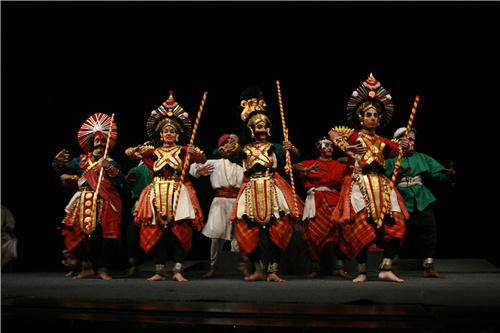
Institution: National School of Drama India
Venue: Experimental Theatre, the Central Academy of Drama, China
Time: 16:00-17:30/19:15-20:45, May 19, 2008
Event: ATEC 3rd International Forum

Director’s Notes
Yakshagana is a performing art form with a history of 4 to 5 centuries. Like in other parts of India, this art form is an outcome of the Bhakti movement. The source text for the performance of this form is derived from mythological tales of Bhagvata and the epics of Ramayana and Mahabharata. There are five elements in Yakshagana. They are: 1. Himmela-Theatre musicians composing of the Bhagavat (Vocalist), Chanda Player, Mridangam play, etc.: 2. Aharya (Costume and Makeup): 3. Nritya (Dance movements); 4. Stylised Speech (Vachika); 5. Abhinaya or Acting/Performing.
Nature and art are inseparable for existence in nature, man devised methods of hard physical labour and he also devised methods for relief from the daily routine. The relief devices led to the intense involvement and nurturing of art. The birth and growth of art have a great influence on the work culture of the community. The religious rituals of the community also play an important role.
The work culture of a community rules the physical senses while the religious rituals rule the extra sensory senses, of the artists. The conglomeration and output of these two worlds of the inner and outer pave the path for art in a community. Folk forms emerge and with structuring over a period of time, they become classical in nature. A practice over a long time makes an art traditional. The state of Karnataka has varied and innumerable folk forms. A modern or contemporary Theatre Practitioner should keep in touch with the art of his natural surroundings.
A present project tries to pave through a journey into the discovery of the cultural roots of this region.

Synopsis
Lord Shri Rama, the King of Ayodhya, hears the pleadings of the' Forest Keeper'(Vanapalak) and leaves to enter the Dandakaranya forest alons with Lakshmana. He enters the forest to slay the wild animals. At the same time Shoorpanakha, who has been insulted by Rama and Lakshman previously in life, after seeing them, seeks to take revenge. She takes the form of Mohini and tries to invoke love from Rama and tries the same with Lakshmana, but after being discarded by both, Shoorpanakha schemes and calls on Karamba and Pralamba, Rakshashas from the forest. She orders them to engage Rama and Lakshmana in the forests, while at the same time, she decides to enter the palace of Sita In the disguise of a Yogini, she persuades Sita to draw a picture of Ravana with hesitation; Sita draws the toe of Ravana, from her memory. The Yogini completes the picture and forces Sita to enliven the picture, and goes away. Sita who is pregnant, realizes the danger and hides the picture in the palace. Rama who returns from hunting, sees the picture of Ravana which is full of life. Rama questions this matter with Sita in front of the elder, friends and all... As Lord Rama, he orders Lakshmana to leave Sita in the forest where she meets Hanuman and then Valmiki who gives shelter to Sita in the forest.

